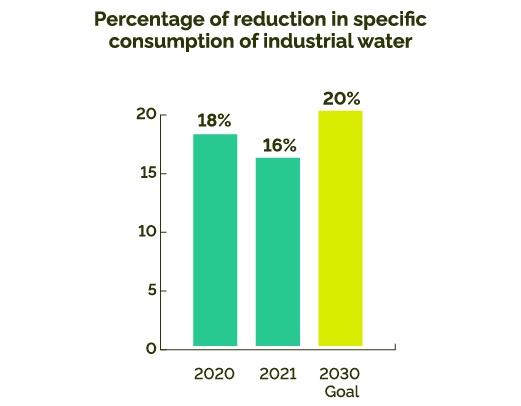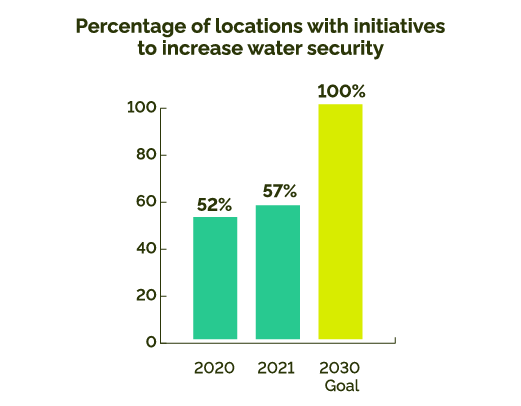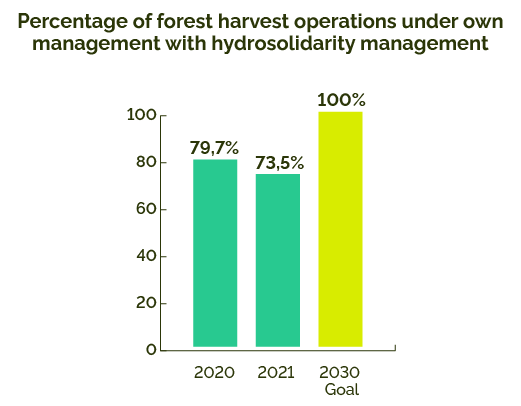Water use management
Water is one of the most important inputs in Klabin's production processes, especially for pulp and paper. The Company seeks to manage its use with a focus on economy (consumption reduction) and reuse, in addition to compliance with environmental laws and regulations.
In addition to the KSDGs related to the topic (described below), the Company's commitment was reinforced in 2021 with the issuance of the Sustainability Linked Bond (SLB), for which the selected goals included water consumption equal to or below 3.68 m3 per ton of production until 2025, equivalent to a 16.7% reduction from the level verified in 2018 (more information about the SLB in Economic performance)
KSDGs goals until 2030
-
Reduce specific industrial water consumption by 20%, with 2018 as the base year;
-
Conduct 100% of forest operations under own management with hydrosolidarity management;
-
Have initiatives to increase territorial water security in 100% of the locations where the company operates.
Participation in committees
Klabin representatives actively participate in discussions on water use in forums* of various regions.
WRI Aqueduct
The tool is used by Klabin to measure the ratio of total annual water withdrawal to the available annual renewable supply. Rates higher than 20% represent areas of water stress.
Hydrosolidarity in water management
The pioneering initiative by Klabin seeks to verify the best practices in forest management to extinguish or minimize impacts on microbasins.
*Tibagi River Basin Committee (PR), Canoas-Pelotas River Basin Committee (SC), Piracicaba, Capivari and Jundiaí River Basin Committee (SP) and the Goiana River Basin Committee (PE).
In 2021, Klabin withdrew, on average, 22.1 m3 of water per ton of product, but effectively consumed only 3.73 m3 of water per ton of product. This is because part of the volume used remains in the final product and part of it evaporates during the industrial process. The water withdrawn that is not retained in the product or does not evaporate is fully treated and returned to the water bodies. The important thing is that, of the total water used, more than 83% is returned to the receiving bodies.

The drop in the percentage of specific consumption reduction (per ton produced) mainly occurred due to the acquisition and integration of the five International Paper units. Still, even with the start-up of MP27, the Puma Unit, our largest unit, was able to improve this indicator, reaching an 15% reduction of specific consumption at the unit, through water efficiency in the process and initiatives for water and effluent reuse.

The WRI Aqueduct tool evaluates water stress in all the Company's units, guiding its action priorities in the most vulnerable territories. Actions adopted in 2021 that contributed to the result include the installation of new Effluent Treatment Stations in the Manaus and Betim units, the participation in Regional Development Forums in Angatuba and Goiana, taking the topic for discussion, and environmental education actions in Klabin's Caiubi Program.

The increase in wood purchases and the decrease in harvesting in own areas were the main reasons for the percentage drop in 2021, an oscillation considered normal from an operational point of view. Klabin is working to include other forest units, taking into account its expansion, in order to reach the KSDG of 100% of the areas analyzed under the hydrosolidarity management flow. Among the initiatives performed in 2021 are the consolidation of the watershed mapping methodology and the elaboration of the hydrological constraints map for new scenarios, which may influence the assumptions in other locations.
Impacts related to the disposal of effluents
IFC/IPCC: acronym for the Intergovernmental Panel on Climate Change. Created by the United Nations Environment Program (UN Environment) and the World Meteorological Organization (WMO), it aims to provide policy makers with regular scientific assessments of climate change, its implications and possible future risks, as well as propose adaptation alternatives and damage mitigation policies.
VER GLOSSÁRIOEffluent disposal
BOD5: acronym for biochemical oxygen demand. This is a standard test, performed at a constant temperature and during a five-day incubation period, to measure the oxygen consumption in water. It is measured by the difference of the amount of dissolved oxygen (DO) found before and after the incubation period.
SEE GLOSSARYCOD: acronym for chemical oxygen demand. This is an indispensable parameter for studies on sanitary sewage and industrial effluents. It assesses the amount of dissolved oxygen (DO) consumed in an acid medium that leads to the degradation of organic matter.
SEE GLOSSARYTertiary treatment at the Puma Unit ensures disposal standards easily absorbable by the water body.
In 2021, the start-up of MP 27 at the Puma Unit and the five new units acquired from International Paper caused a 6% increase in the volume of water discharged by the Company compared to 2020.
See GRI indicators 303-1, 303-3, 303-5 and others related to the material topic Water use in the ESG Panel.







